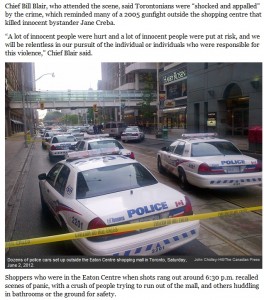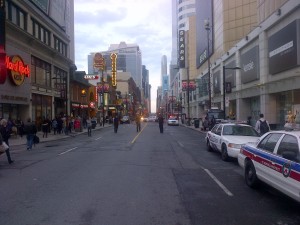Covering the Eaton Centre shooting

This is the first photo I took on my Blackberry shortly after arriving on the scene at the Eaton Centre shooting, as shown on the National Post's website.
One of the best parts of being a journalist is that every day is different.
The multiple shooting at Toronto’s Eaton Centre on Saturday was a classic example of how a sleepy afternoon shift can quickly change into one of the biggest stories of the year.
I’d been scheduled to work on the broadcast side of the sports desk from noon until 8 p.m. Around 6:45 we noticed Toronto Blue Jays third baseman Brett Lawrie was tweeting that there were shots fired at the Eaton Centre.
Now, keeping tabs on Twitter is pretty standard operating procedure in the sports department. It helps us keep track of breaking news and we can grab quotes for use in our stories. Many athletic associations use Twitter for news releases and, of course, professional athletes love to interact with their fans through it as well. It’s an incredibly valuable resource.
Anyway, since multiple shootings is out of the jurisdiction of sports, we told our national/Ontario desk of the news and emailed them a link to Lawrie’s Twitpic and carried on with our business.
Newsrooms, however, are supposed to be modular. If a big news story breaks in one department, our goal is to cover it from every angle. If there’s a pressing assignment, then one department can pull staff from other desks to beef up its coverage.
Unfortunately, the national desk was short staffed because Saturday nights are pretty slow – well, everywhere except in sports.
So with this breaking news, and with my shift winding down (my replacement on the desk had come in), I was pulled off of sports and sent up to the Eaton Centre with video camera and Edirol in hand.
When I got to the intersection of Yonge and Queen it was total mayhem.
By my count there were at least 15 police cars clogging up Queen Street West, with four or five ambulances. All the cops were out of their cars and hastily setting up a perimeter. At the same time, hundreds, if not thousands, of pedestrians were on the street.
At first, most of the civilians were running or jogging away from the mall. I assume these were people who’d actually heard the shots fired or knew what had happened through word of mouth. But after they cleared out there were still hundreds milling about with cameras and phones in the air, pointed at the command centre the police were setting up at the Eaton Centre’s south entrance.
I called in to the national desk to describe the scene to help them put together the initial story. It was a brief call just to let them know that, yes, there was a very real situation with a large police presence and that there were huge crowds of people in and around the mall.
After that, I tried to approach a police officer and ask if they had a media liaison person yet. I knew the answer would be no, but people are more likely to answer other questions if the first one is easy.
He then told me that they were evacuating the Eaton Centre, that it was a “hot” situation and the shooter was still at large.
I shot some video, mainly B-roll stuff of the cops trying to control the crowd, before I moved west along Queen, as close as I could to the main entrance, to get a good framing shot of the police standing outside of one of the mall’s main entrances.
I reached over the police line to try and get the best shot possible and, suddenly, a cop was on me, shouting. He crossed under the tape, turned me around, and started shoving me back towards Yonge Street.
“If you cross my line one more time, I’ll arrest you myself and confiscate your camera,” he said, while pushing me along the sidewalk. “This is an ongoing investigation and I won’t hesitate putting the cuffs on you.”
 Now, I’ll allow that I shouldn’t have reached over the tape, but I think he was coming down a bit heavy. When he finally got me to Yonge I turned back around to get a look at him and I realized just how scared he was. He was a pretty young guy – maybe about 26-years-old – and, unlike some of the cops, had pulled his face into a grimace.
Now, I’ll allow that I shouldn’t have reached over the tape, but I think he was coming down a bit heavy. When he finally got me to Yonge I turned back around to get a look at him and I realized just how scared he was. He was a pretty young guy – maybe about 26-years-old – and, unlike some of the cops, had pulled his face into a grimace.
I wasn’t particularly pleased with being shoved down a street, but that’s fine. I can understand that he was tense and stressed out and don’t bear him or Toronto’s police any ill will. At the end of the day, I was the one in the wrong.
Anyway, as I stood at the corner the Emergency Task Force arrived in a convoy, giving the impression that there could be more gunfire. I caught their arrival on camera and then called back in to the office to give them an update.
After filling in reporter-editor Steve Fairbairn on the latest, I did an interview with broadcaster Bill Marshall to put out on the Canadian Press’ audio wire. It was a fairly standard Q+A session with me describing the situation and giving what little information I had.
Steve told me that he’d also called in Paola Loriggio, another reporter-editor who usually works on the Ontario desk.
I asked another police officer if there was a media liaison yet and tried to get more details on the shooting. He mentioned that the shooting was in the food court and that he was sure the perpetrator was long gone.
Now, normally, the information that the shooting was at the food court would be pretty useless since the Eaton Centre has two – a north one and a south one – but it just so happens I’d been in the mall earlier that day and knew that the south food court was closed for renovations.
I decided to walk north to Dundas, since that entrance would be closer to what appeared to be the site of the shooting. But before I went, I snapped a photo on my Blackberry of all the 5-0 on Queen West.
Along the way, I saw mall security letting several customers and staff members out of the building through a fire exit. I also came across a cluster of McDonald’s employees getting instructions from their manager on getting subway fare from another nearby location.
This was my first chance at an eyewitness interview.
After she was done speaking , I pulled her aside for a quick interview. Although she briefly got nervous, she calmed down when I asked for her name and how to spell it. Turns out I was speaking to Erica Solmes, the prop for the York Lions’ women’s rugby team.
She explained that she’d heard about 15 shots and then a stampede started out of the food court and, presumably, out of the mall.
After a few follow up questions I thanked her for her time and headed up to Dundas Square where I was to meet Paola. Things were still pretty crowded at this intersection since there was a smaller police presence. Oddly, most of the crowd was facing east, looking at the stage set up in the square for a free opera concert.
Paola and I spoke to a few cops, who confirmed that although the shooting was at the Dundas food court, the command centre – and therefore any news conference – would be down on Queen. As we walked back, we saw other members of the media scrumming around a young guy in an Eaton Centre uniform.
Paola waded in to the scrum to get her Edirol in close, while I hung back and held the video camera up and over our fellow journalists.
This was Marcus Neves-Polonio, a 19-year-old busboy who had fled the shooting after ducking for cover under a table.
I felt pretty bad for him, since he was clearly in a state of shock. I’m not sure if it was from the shooting, having a bunch of cameras and microphones in his face, or both. The kid was obviously rattled. After the scrum was done Paola and I continued our walk.
The pictures desk had replied to the photo I’d sent them, asking for more. With that in mind, I stopped to take a shot down Yonge, which was clear except for media, police, and some civilians trying to find their way to public transit.
 When Paola and I arrived at Yonge and Queen we confirmed that there’d be a news conference soon, so I went back to CP’s office to drop off my video camera, email in two more photos from my Blackberry and hand over my Edirol to transcribe Erica Solmes’ quotes.
When Paola and I arrived at Yonge and Queen we confirmed that there’d be a news conference soon, so I went back to CP’s office to drop off my video camera, email in two more photos from my Blackberry and hand over my Edirol to transcribe Erica Solmes’ quotes.
After that, I took a fresh camera out to Paola and called it a night.
All in all, it was a crazy but exciting experience. The photos from my Blackberry got wide distribution on CP’s wire and then the Associated Press’ wire. The B-roll and interview with Marcus Neves-Polonio was the first video CP put out and it also got pretty wide play. Erica Solmes’ quotes and some colour I’d called in were incorporated into our main story.
All from what started as a quiet, laidback shift on the sports desk.
Writing from Twitter
![]() Twitter debuted “Twitter for Newsrooms” on Monday as an online guide for journalists on how to best use the social networking site. It focuses on enhancing the quality of online content as well as the quick dissemination of that content to a wider audience.
Twitter debuted “Twitter for Newsrooms” on Monday as an online guide for journalists on how to best use the social networking site. It focuses on enhancing the quality of online content as well as the quick dissemination of that content to a wider audience.
I think this is a great idea. As long time readers of this blog know, I’ve been a fan of Twitter for years and I regularly use it to promote my own writing and as a forum for my alleged wit.
There’s no better way to keep track of breaking news stories. I’ve learned about dozens of trades through the Trending Topics feature and have often learned about other hot stories through Twitter. In fact, most of the feature stories I read I’ve discover through Twitter.
In other words, I’m really looking forward to exploring TfN.
Coincidentally, the Canadian Press had been using Twitter as a source for quotes for some time, taking the tweets of athletes (or politicians or whoever) from verified accounts to add colour to our news stories.
Recently, CP’s sports department has composed entire stories from these tweets, adding greater context to developing stories. I’ve written two of these articles.
The first was reactions from NHLers (and NBA star Steve Nash) on the pivotal Game 6 of the Stanley Cup final between the Vancouver Canucks and Boston Bruins.
“NHLers react on Twitter to Game 6 action”
Watching Game 6 of the Stanley Cup final brought back some emotional memories for Bret Hedican, something the retired NHL veteran was only too happy to share with the world.
Hedican was one of several NHL players, both current and retired, took to the social networking site Twitter on Monday night to weigh in on the Boston Bruins' 5-2 victory over the Vancouver Canucks.
"I've won and lost a Stanley Cup game 7!," Hedican tweeted. "I remember both like they were yesterday! Heartbreak & Elation!" (Read more…)
On Sunday we applied the same idea to the opening match of FIFA’s Women’s World Cup as Canada took on Germany.
“Soccer fans cheer on Canadian women against Germany via Twitter in World Cup”
As Christine Sinclair scored for Canada’s in its 2-1 loss to Germany at FIFA’s Women’s World Cup on Sunday, fans and players took to Twitter, often tweeting directly at the forward.
“@sincy12 That was soooo pretty! Love watching you play! Come on, 1 more!!” said Leslie Osborne, a former player with the U.S. national team and current captain of Women’s Professional Soccer’s Boston Breakers after the strike at the 82nd minute.
Despite playing most of the second half with a broken nose after taking an elbow in the face, Sinclair scored in the 82nd with a brilliant free kick to the top right corner, cutting Canada’s deficit to one and shocking the German fans. (Read more…)
I think that both articles did well to take advantage of the instant access afforded by Twitter and also allowed for more candid – if horribly written – comments from athletes who’ve been trained to clam up whenever a microphone is in front of them.
Hopefully, “Twitter for Newsrooms” helps CP and other news organizations take full advantage of social networking sites.
Where have I been?

A corner of the Canadian Press newsroom in Toronto. Not my corner though. This picture is from Centennial College's journalism blog, taken by Gesila Azorbo.
As you can see, I haven’t posted on this blog since – yikes – the middle of April.
Where has all my writing energy gone? To the Canadian Press, of course.
In early March I was taken off the junior hockey beat and bumped up to a reporter-editor on the sports desk. Since then, I’ve been working between three and six shifts a week covering anything that comes across my desk, sometimes on day shifts and sometimes at night.
There are four “spots” on the sports desk that a reporter-editor fills.
Broadcast news – Broadcast News was a separate company that for years provided television and radio stations with copy for announcers to read. The Canadian Press bought BN and eventually merged it into its main news wire service. The BN desk is still responsible for writing and editing copy primarily for our broadcast wire and taking care of audio-visual material.
This means turning around audio clips for TV and radio stations and writing what we call sportsbreaks and minutes.
You’ll hear this copy on the radio, typically on a non-sports station. Consider a classic rock station. If the DJ isn’t a big sports fan, or is too busy managing the songs on the station, they just use our sportsbreak to run down the latest sports news every hour or so. The writing is simple, brief and designed to be easily read by those unfamiliar with the pronunciation of athletes names.
For example, recent NBA playoff MVP Dirk Nowitzki would be written as “recent N-B-A playoff M-V-P Dirk Nowitzki (noh-VIHT'-skee)”.
Second chair – On the sports desk the second chair has a lot of names. “Second chair”, “second editor”, “little chair”. Generally, this editor is responsible for Canadianizing copy from the Associated Press by highlighting the accomplishments of Canadian athletes (“Toronto’s Joey Votto”) and fixing words to their Canadian spelling (dueled becomes duelled, among countless other changes).
The second chair might also write fresh copy, from box score, press release or phone interview. Most often, it’s a combination of all three. However, all that is at the discretion of the slotperson.
Slotperson – The slot is the person in charge of the desk. They dish out assignments and are the final arbiter of what is or isn’t newsworthy. The morning slotperson is the first to arrive and the evening slot is the last to leave at – God help them – 3 a.m. I haven’t had many of these shifts since I’m pretty new to the desk, but it does happen.
The slotperson does everything the second chair does, only more of it and is expected to take responsibility for the biggest story of the day, whatever it may be.
General assignment – On occasion senior reporter-editors are put on general assignment so they can pursue feature stories or develop their beat. For example, our Canadian Football League writer Dan Ralph has been preparing for the upcoming season and hockey writer Chris Johnston has been getting ready for the NHL draft. I’m not yet senior enough to do GA, but I still thought I’d mention this desk task.
All this adds up to me being a very busy guy. I’ve gone stretches with 12 shifts in 13 days.
Unfortunately, as much as I love writing, reading and editing, it’s hard to get jazzed about it when you’ve already done it for seven hours that day.
In any event, now that I’m becoming more comfortable on the desk I’ll be coming back here a lot more. I’ve got some book reviews coming up for Chapters-Indigo that I’ll cross-post here as well as some pieces specifically for this blog as well as some work for my friends over at HockeyPrimeTime.com.